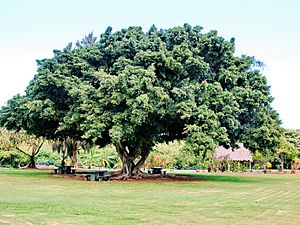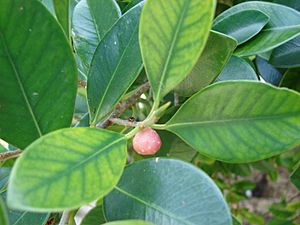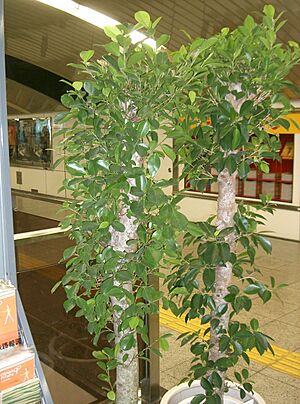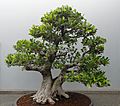Chinese banyan facts for kids
Quick facts for kids Chinese banyan |
|
|---|---|
 |
|
| Scientific classification | |
| Kingdom: | |
| (unranked): | |
| (unranked): | |
| (unranked): | |
| Order: | |
| Family: | |
| Genus: | |
| Species: |
F. microcarpa
|
| Binomial name | |
| Ficus microcarpa L.f. 1782
|
|
| Synonyms | |
|
|
Ficus microcarpa, also known as the Chinese banyan or Indian laurel, is a type of tree in the fig family. It is native to a wide area, from China through tropical Asia and the Caroline Islands all the way to Australia. People often plant it as a shade tree because of its wide, spreading branches.
Contents
About the Chinese Banyan
How it got its name
The Ficus microcarpa was first described in 1782 by a scientist named Carl Linnaeus the Younger. This tree has many different scientific names, but Ficus microcarpa is the most common one.
There is also a special type called Hill's weeping fig. It was first described as its own species, Ficus hillii, in Australia. Later, in 1965, it was decided that it was actually a variety of Ficus microcarpa. Its full name became Ficus microcarpa var. hillii.
What it looks like
The Chinese banyan is a tropical tree. It has smooth, light-gray bark and oval-shaped leaves that are about 2 to 2.5 inches (5–6 cm) long. In places with a Mediterranean climate, it can grow to about 40 feet (12 meters) tall. Its branches can spread out just as wide.
In warmer, humid places like the tropics, it can grow much larger. It often develops many "prop roots" that grow down from its branches into the ground. These roots help support the tree and make it look very wide.
Some of the biggest Ficus microcarpa trees are found in Hawaii.
- One tree, called Auntie Sarah's Banyan, is 110 feet (33.5 meters) tall. Its crown spreads 250 feet (76.2 meters) wide. It has over a thousand aerial trunks!
- Another tree in Hawaii has the thickest trunk, measuring 28 feet (8.5 meters) thick.
Where it grows
Native home
The Chinese banyan is originally from places like Sri Lanka, India, southern China, the Malay Archipelago, Ryukyu Islands, Australia, and New Caledonia. It loves warm weather and humid air. This tree can even handle temperatures close to freezing (0 °C). You can often find it in tropical rainforests, along rivers, on coasts, and in swamps.
New homes around the world
People have planted Ficus microcarpa all over the world as an ornamental tree. It is a very common street tree in warm areas. You can find it in North Africa, Iraq, Japan, and Hawaii. In America, it was brought to Florida and Central and South America.
These trees are very tough. They can grow in cracks in walls, buildings, and other concrete structures in cities. They can even handle some pollution in the air and soil.
The tiny fig wasp called Eupristina verticillata helps the tree make seeds. This wasp was also brought to new places along with the tree. Sometimes, it takes a while for the wasp to arrive. For example, in Brazil, the trees were planted in the 1800s, but new saplings (young trees) only started growing in the 1970s after the wasp arrived. These new saplings can be very strong and grow on buildings or bridges.
The Chinese banyan is considered an invasive species in places like Hawaii, Florida, and Bermuda. This means it can spread quickly and take over areas where native plants used to grow. In Southern California, the fig wasp is now established, so the trees can produce fertile seeds. Birds eat the fruit and spread the seeds, allowing the trees to grow on their own. They can even grow on other trees, especially palm trees.
You can also find this tree commonly planted along the Mediterranean coast of Spain, in the Balearic Islands, Canary Islands, Sicily, Rhodes, and Cyprus.
Tree life and nature
Fig wasps
The Ficus microcarpa tree has a special relationship with the Eupristina verticillata fig wasp. This wasp helps the tree reproduce by pollinating its flowers. There are also other types of wasps that live in the figs but do not help with pollination.
Birds and other animals
In some places where it has been introduced, the tree's fruits are very popular with birds. In São Paulo, Brazil, ten different bird species eat its fruits. Some of these birds include the rufous-bellied thrush and the great kiskadee. Parrots also enjoy eating its fruit and leaves. Even though it can be an invasive plant, its strong nature means it helps attract birds to cities.
Growing and using the tree
Cultivation
People grow Ficus microcarpa as an ornamental tree in gardens and parks. It is also a popular indoor plant and is often used for bonsai (the art of growing miniature trees). In Southeast Asia, it is planted for its dense leaves, which provide good shade. It can also be shaped into a hedge or bush.
Since it is a tropical tree, it prefers temperatures above 20 °C (68 °F) all year round. This is why it is often sold as a houseplant. However, it can survive in cooler temperatures, only getting damaged below 0 °C (32 °F). High humidity is good for it, especially for growing its aerial roots. You can easily grow new trees from cuttings placed in water or soil.
There is an Australian type called Ficus Emerald Green. It has shiny green leaves and grows upright. It can be used in formal gardens as a hedge or shaped like a 'lollipop' in a pot.
Traditional medicine
The Chinese banyan is also used in traditional medicine in India, Malaysia, China, and Japan. In Japan, the bark, aerial roots, and dried leaves are used to help with pain and fever. In China, the plant is used for things like the flu, malaria, bronchitis, and rheumatism. Scientists are studying its properties, which might include being good for antioxidants, fighting bacteria, and helping with cancer or diabetes.
Folklore and beliefs
In Southeast Asia, people sometimes believe that Ficus microcarpa trees are home to spirits. In China, large fig trees can be linked to good spirits and important life energy, called "Qi". In Singapore, some of these trees are seen as special places for worship by Buddhists and Taoists.
Gallery
-
A tree in Midway Atoll
-
An avenue of Ficus microcarpa in Hyde Park, Sydney
-
Ficus microcarpa living on Phoenix dactylifera. It is there due to Guano of flying Egyptian fruit bat
Images for kids
-
Ficus microcarpa is a common tree seen alongside streets of Los Angeles area and generally its the most common evergreen fig in southern California
See also
 In Spanish: Laurel de Indias para niños
In Spanish: Laurel de Indias para niños






















